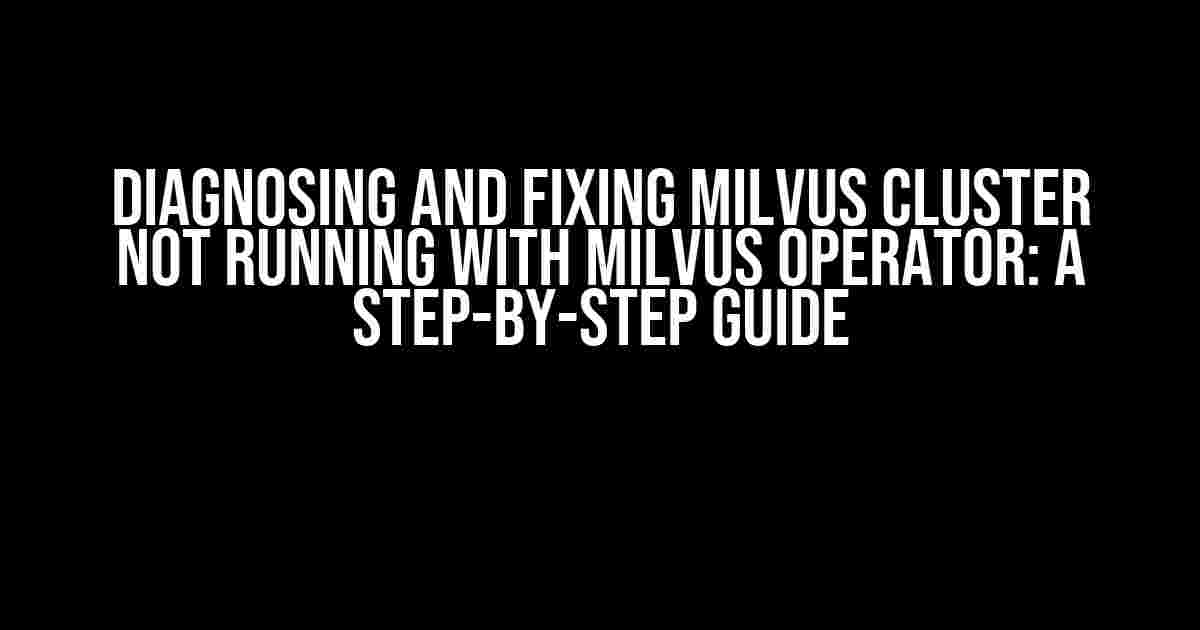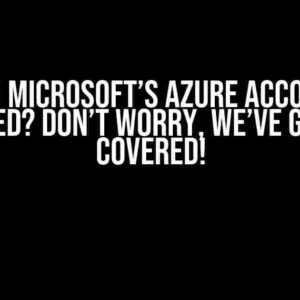If you’re reading this article, chances are you’re frustrated with your Milvus cluster not running as expected with the Milvus Operator. Don’t worry, you’re not alone! In this comprehensive guide, we’ll walk you through the common issues, troubleshooting steps, and solutions to get your Milvus cluster up and running in no time.
Understanding Milvus and Milvus Operator
Before we dive into the troubleshooting process, let’s quickly review what Milvus and Milvus Operator are.
Milvus is an open-source vector database that allows you to store, manage, and search large volumes of vector data efficiently. It’s designed for AI applications, such as computer vision, natural language processing, and recommender systems.
Milvus Operator is a Kubernetes operator that simplifies the deployment, management, and scaling of Milvus clusters on Kubernetes. It provides a convenient way to manage Milvus resources, such as deployments, services, and pods, using Kubernetes-native APIs and tools.
When your Milvus cluster isn’t running as expected, it can be due to various reasons. Here are some common issues you might encounter:
- POD Errors**: Pod creation fails, or pods are not running as expected.
- Deployment Issues**: Deployments are stuck, or replicas are not created.
- etcd Connection Issues**: etcd connection errors prevent Milvus from functioning correctly.
- Resource Constraints**: Insufficient resources, such as CPU or memory, hinder Milvus cluster performance.
- Milvus Configuration Errors**: Incorrect configuration settings or typos in the Milvus YAML file.
Step-by-Step Troubleshooting Guide
Let’s get started with the troubleshooting process! Follow these steps to identify and fix the issue:
Step 1: Check Milvus Operator Logs
First, check the Milvus Operator logs for any errors or warnings. You can do this by running the following command:
kubectl logs -f milvus-operator- controller-manager -n milvus-operator-systemLook for any error messages or warnings that might indicate the issue.
Step 2: Verify Milvus Cluster Status
Check the Milvus cluster status using the following command:
kubectl get milvusclusters -n milvus-operator-systemThis command will show you the current status of your Milvus cluster. Look for any errors or issues that might be preventing the cluster from running.
Step 3: Inspect Pod Logs
If you’ve identified a specific pod that’s not running as expected, check the pod logs using the following command:
kubectl logs -f -n milvus-operator-system Replace `
Step 4: Verify etcd Connection
kubectl exec -it -n milvus-operator-system -- etcdctl cluster Replace `
Step 5: Check Resource Constraints
Make sure you have sufficient resources (CPU, memory, and storage) to run your Milvus cluster. You can check the resource usage using the following command:
kubectl top pod -n milvus-operator-systemThis command will show you the resource usage for each pod in the Milvus namespace. Identify any pods that are consuming excessive resources and adjust accordingly.
Step 6: Review Milvus Configuration
Milvus configuration errors can prevent the cluster from running correctly. Review your Milvus YAML file for any typos or incorrect settings. You can check the Milvus configuration using the following command:
kubectl get milvusclusters -n milvus-operator-system -o yamlVerify that the configuration settings are correct and adjust as needed.
SOLUTIONS TO COMMON ISSUES
Now that we’ve covered the troubleshooting steps, let’s dive into the solutions to common issues:
Solution 1: Fix Pod Errors
If you’ve identified a POD error, try restarting the pod using the following command:
kubectl delete pod -n milvus-operator-system Replace `
Solution 2: Resolve Deployment Issues
If you’re experiencing deployment issues, check the deployment YAML file for errors. You can verify the deployment configuration using the following command:
kubectl get deployments -n milvus-operator-system -o yamlMerge the changes to the deployment YAML file and reapply the configuration.
Solution 3: Fix etcd Connection Issues
To fix etcd connection issues, try restarting the etcd service using the following command:
kubectl rollout restart deployment etcd -n milvus-operator-systemThis will restart the etcd service and resolve connection issues.
Solution 4: Resolve Resource Constraints
If you’re experiencing resource constraints, try scaling up or down the Milvus cluster to adjust the resource usage. You can do this using the following command:
kubectl scale milvusclusters -n milvus-operator-system --replicas= Replace `
Solution 5: Fix Milvus Configuration Errors
If you’ve identified a Milvus configuration error, update the Milvus YAML file with the correct settings. You can apply the changes using the following command:
kubectl apply -f milvus.yaml -n milvus-operator-systemReplace `milvus.yaml` with the actual name of your Milvus YAML file.
CONCLUSION
Troubleshooting a Milvus cluster not running with Milvus Operator can be a daunting task, but with this comprehensive guide, you should be able to identify and fix the issue. Remember to check Milvus Operator logs, verify Milvus cluster status, inspect pod logs, verify etcd connection, check resource constraints, and review Milvus configuration. By following these steps and implementing the solutions to common issues, you’ll be able to get your Milvus cluster up and running in no time.
If you’re still experiencing issues, don’t hesitate to reach out to the Milvus community or seek further assistance from Milvus experts.
| Issue | Solution |
|---|---|
| Pod Errors | Restart the pod |
| Deployment Issues | Resolve deployment configuration issues |
| etcd Connection Issues | Restart the etcd service |
| Resource Constraints | Scale up or down the Milvus cluster |
| Milvus Configuration Errors | Update the Milvus YAML file with correct settings |
By following this guide, you’ll be able to troubleshoot and fix common issues with Milvus clusters not running with Milvus Operator. Remember to stay calm, be patient, and don’t hesitate to seek further assistance if needed.
Frequently Asked Question
If you’re having trouble getting Milvus Cluster up and running with Milvus Operator, don’t worry! We’ve got you covered. Check out the following FAQs to troubleshoot the issue.
Why does my Milvus Cluster not start after installing Milvus Operator?
This might be due to incorrect configuration or installation. Double-check your Milvus Operator installation and ensure that you’ve followed the correct steps. Also, verify that your Kubernetes cluster meets the minimum requirements for Milvus Operator.
How do I check the Milvus Operator logs to identify the issue?
You can check the Milvus Operator logs using the command `kubectl logs -f
What if my Milvus Cluster is stuck in a pending state?
If your Milvus Cluster is stuck in a pending state, it might be due to resource limitations or conflicting configurations. Try scaling up your Kubernetes cluster resources or adjusting the configurations to resolve any conflicts.
Can I customize Milvus Operator’s configuration to resolve the issue?
Yes, you can customize Milvus Operator’s configuration by modifying the `milvus.yaml` file or using Kubernetes configurations. However, be cautious when making changes, as they might affect the overall performance and stability of your Milvus Cluster.
Who can I reach out to for further assistance?
Don’t hesitate to reach out to the Milvus community or our support team for further assistance. We’re here to help you troubleshoot the issue and get your Milvus Cluster up and running smoothly.


